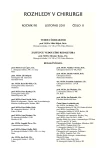Penetrating Thoracic and Abdominal Injuries: Diagnostic and Therapeutic Approach
Authors:
F. Vyhnánek; L. Novák; D. Jirava; M. Očadlík
Authors‘ workplace:
Traumatologické centrum FNKV, Chirurgická klinika FNKV a 3. LF UK, Praha
Published in:
Rozhl. Chir., 2011, roč. 90, č. 11, s. 642-646.
Category:
Monothematic special - Original
Overview
Introduction:
Penetrating thoracic or abdominal or combined injuries are associated with high risk of life-threatening intraabdominal or intrathoracic organ injury. Most patients require acute surgery. When miniinvasive technique is available, thoracoscopic or laparoscopic intervention is indicated in hemodynamically stable patients to evaluate severity of the injury, as well as to treat the condition.
Aim of the Study:
Retrospective analysis of incidence, diagnostics and treatment of penetrating thoracic and abdominal injuries and combined thoracoabdominal injuries in a Trauma centre.
Patients, Methods and Results:
A total of 195 patients with penetrating thoracic, abdominal or combined injuries, who were hospitalized in the FNKV (Královské Vinohrady Faculty Hospital) Trauma centre in Prague from 1999 to 2010, were included in the study. The study group included 177 (91%) males. Out of the total, 102 patients (53%) suffered from penetrating abdominal injuries, 71 (36%) from thoracic injuries and 22 (11%) from combined, thoracoabdominal injuries. The majority of injuries were stab injuries (173, i.e. 89% of the patients). 22 subjects, the penetrating injury was caused by shot injuries. In stable patients, MDCT has been lately used to establish the diagnosis. In 171 subjects, acute thoracotomy or thoracotomy was indicated. Patients with combined injuries of the both cavities were indicated either for thoracotomy and laparotomy or thoracophrenolaparotomy. Videothoracoscopy or laparoskopy was conducted in 21 (11%) of the subjects. During the surgical revision, two subjects exited due to ireversible hemorrhagic shock, further 2 subjects died because of septic complications following shot abdominal injuries.
Conclusion:
Incidence of penetrating thoracic, abdominal or combined thoracoabdominal injuries is fairly rare in our country. Subjects with unstable hemodynamic conditions are indicated for acute thoracotomy or laparotomy. Miniinvasive procedures have diagnostic and therapeutic benefit in stable patients. Diagnostic thoracoscopy and laparocopy provides evidence of some injuries (diaphragm, alimentary tract). Therapeutically, miniinvasive methods may be used to manage the source of bleeding and for targeted drainage. Non-surgical procedure is the method of choice in a selected group of hemodynamically stable patients with stab injuries, with monitoring of the patient’s condition, including the use of x-ray imaging.
Key words:
penetrating thoracic and abdominal injuries – diagnostics and treatment
Sources
1. Mandal, A. K., Sanusi, M. Penetrating Chest Wounds: 24 years experience. World J. Surg., 2001; 25: 1145–1149.
2. Asensio, J. A., Arroyo, H., Veloz, W., et al. Penetrating thoracoabdominal injuries: ongoing dilema- which cavity and when? World J. Surg., 2002; 26: 539–543.
3. Biffl, W. L., Moore, E. E. Management guidelines for penetrating abdominal trauma. Curr. Opin. Crit. Care, 2010; 16: 609–617.
4. Butt, M. U., Zacharias, N., Velmahos, G. C. Penetrating abdominal injuries: management contraversies. Scand. Trauma Resusc. Emerg. Med., 2009; 17: 19–29.
5. Velmahos, G., Constantinos,C., Tillou, A., et al. Abdominal computer tomographic scan for patients with gunshot wounds to the abdomen selected for non-operative management. J. Trauma, 2005; 59: 1155–1160.
6. Sproviero, J. The role of ultrasound in penetrating trauma. Eur. J. Trauma Emerg. Surg., 2010; 36: 138–144.
7. Demeš, R., Čermák,S., Výborný, J., et al. Videotorakoskopie a videoasistované chirurgické výkony u penetrujících poranění hrudníku. Rozhl. Chir., 2001; 80: 304–307.
8. Ahmed, N., Chung, R. Role of early thoracoscopy for management of penentrating wounds of the chest. Am. Surg., 2010; 76: 1236–1239.
9. Inaba, K., Demetriades, D. The nonoperative management of penetrating abdominal trauma. Adv. Surg., 2007; 41: 51–62.
10. Demetriades, D., Hadjizacharia, P., Constantinou, C., et al. Selective nonoperative management of abdominal solid organ injuries. Ann. Surg., 2006; 244: 620–628.
11. Murray, J. A., Demetriades, D., Asensio, J. A., et al. Occult injuries to the diaphragm: prospective evaluation of laparoskopy in penetrating injuries to the left lower chest. JACS, 1998; 187: 626–630.
12. Bergeon, E., Lavoie, A., Razek, T., et al. Penetrating thoracoabdominal injuries in Quebec: implications for surgical training and maintenance of competence. Can. J. Surg., 2005; 48: 284–288.
Labels
Surgery Orthopaedics Trauma surgeryArticle was published in
Perspectives in Surgery

2011 Issue 11
- Metamizole vs. Tramadol in Postoperative Analgesia
- Metamizole at a Glance and in Practice – Effective Non-Opioid Analgesic for All Ages
- Current Insights into the Antispasmodic and Analgesic Effects of Metamizole on the Gastrointestinal Tract
Most read in this issue
- Acute Mediastinitis
- Lung Transplantation
- Esophageal Perforation
- Are There Any News in the Management of Spontaneous Pneumothorax?
